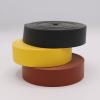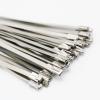
Innovation is a constant in the aerospace industry, and cables and wiring are no exception, they are central to the design and functionality of planes.
Before every take-off, pilots, flight attendants, grounds people and everyone on board a plane has a long list of tasks to ensure an easy and safe flight. Like their own checklist, successful cable management begins far before take-off and is crucial to keeping up with trends in aerospace design and safety.
In the Innovative cables and cabling solutions for next-generation Aerospace Nexans paper, “Aircraft designers have increasingly replaced mechanical and hydraulic systems with electrical systems (fly-by-wire) causing the amount of electrical power carried by the aircraft Electrical Wire & Interconnect System (EWIS) to almost double.”
The aerospace industry is currently in flux trying to respond to needs to make the sector more environmentally friendly with an increase in electrical systems while also coping with huge losses caused by the ongoing COVID-19 pandemic. The International Air Transport Association estimates the industry will require a cash infusion of up to $200 billion, as well as loan guarantees to weather the economic buffeting.
According to model, size, passenger capacity and specifications, every airliner contains from 200 to 600 km of cables interconnecting vital equipment throughout the airplane. Wires provide everything from power, data, sensor information, flight management control, avionics, and communications to overhead and emergency lighting and inflight entertainment.
The challenge faced by engineers and electricians is how to make lighter-weight cable designs to meet new needs for economic and environmentally friendly planes, additionally with no added compromise on safety, performance and reliability. “Advances in aerospace cable have required thinner insulations, increased use of aluminum for general purpose wires, cables that can endure much higher temperatures in hot engine zones, or offer higher working voltages.”
Read on to find out how important cable management is in the aero-space and how it's helping change travel.
Environmentally friendly cable management
The aerospace industry is quite pollution heavy and according to the Center for Climate and Energy Solutions, it produces 2% of all human-created CO2 emissions. So how can cable management help the aerospace industry be more environmentally friendly?
Discussed in an article for Cable Gem Solutions is the beneficial impact that would occur by improving a plane's fuel efficiency. One way to do this is by reducing the drag, thus reducing the amount of fuel required by a plane's journey. Fuel accounts for 30% of airline costs, and the heavier a plane is the more fuel required to fly it. “Cable management offers a simple solution to this, as plane wiring controls all essential functions from lighting to entertainment, communication and overall power.” To give an example, the double decker Airbus A380 contains 320 miles of wiring.
Each of these wires comes with its own set of connectors and other vital pieces of equipment that help to keep the plane running. Given that a plane’s wiring accounts for around 3% of its weight, a more innovative approach to cable management could contribute significantly to reducing weight, which will reduce drag, therefore increasing fuel efficiency.
“Lighter wires and cables are going to be essential for the future of cable management and will provide the aerospace industry with an effective way to help reduce the weight of each plane – as well as its environmental impact.”
Improvements in aerospace cable management
Along with environmentally friendly advances, aircraft designs are constantly being upgraded to ensure the latest in-flight entertainment like wifi and on-board TV viewing. These updates require the latest in integrated wire management solutions for the cabins to protect, manage and route wiring systems.
One example of a management system is co-extrusions. Pexco Aerospace defines this as combining two functional parts into one single profile. For example, combining an aesthetic sidewall to floor transition with a hidden cable management compartment, all as one single part. Cable management in aerospace design helps to achieve the “heavy task of flying light.” By maximising weight savings coupled with better performance.
Cable lacing is an example of an older cable management technique that is still used today in aerospace, telecommunication, and naval applications. It is a great technique used to bind groups of cables because it does not create obstructions along the length of the cable, thus avoiding the handling problems of cables held in place by plastic or hook-and-loop cable ties.
Using a thin cord made of waxed linen, cable lacing binds together groups of cables using running lock stitches. The tapes used in these applications are also found in standard heat shrink tubing like teflon, fiberglass and polyester to improve knot holding.
To successfully cable lace, users begin with a knot like a whipping knot to secure free ends. The wraps are then spaced based on the overall harness diameter to maintain a neat, tight bundle for the wiring. In some cases stand-alone knots called spot ties are also used. For large cables and cable bundles, other examples of applicable cable lacing styles are the Chicago stitch and Kansas City stitch.
Heat shrink tubing
Along with techniques like cable lacing and co-extrusions, heat shrink tubing is pivotal in the success of helping the aerospace industry become more economic and environmentally friendly. Airlines, cargo transport and military operations are increasingly global and need a wide range of cable solutions that are fully compliant with national and world standards.
Airplane designs require lighter, smaller, tougher, and more reliable wires and cables. Heat shrink tubing is essential in this transition as they help streamline cabling, ensuring they are abrasion, fire and liquid resistant, and low maintenance.
Heat shrink tubing also ensures better bundling and other customized solutions based on material, size, insulating properties and finally laser marking to identify wires.
Have more questions about cable management in aerospace?
Hopefully, this article has helped you better understand cable management in the aerospace industry and how heat shrink tubing is essential to this. Set up an account or log in to put in an order.
If you have additional questions, visit our learning center or FAQs. Or you can contact us here with questions or to receive a sample.








